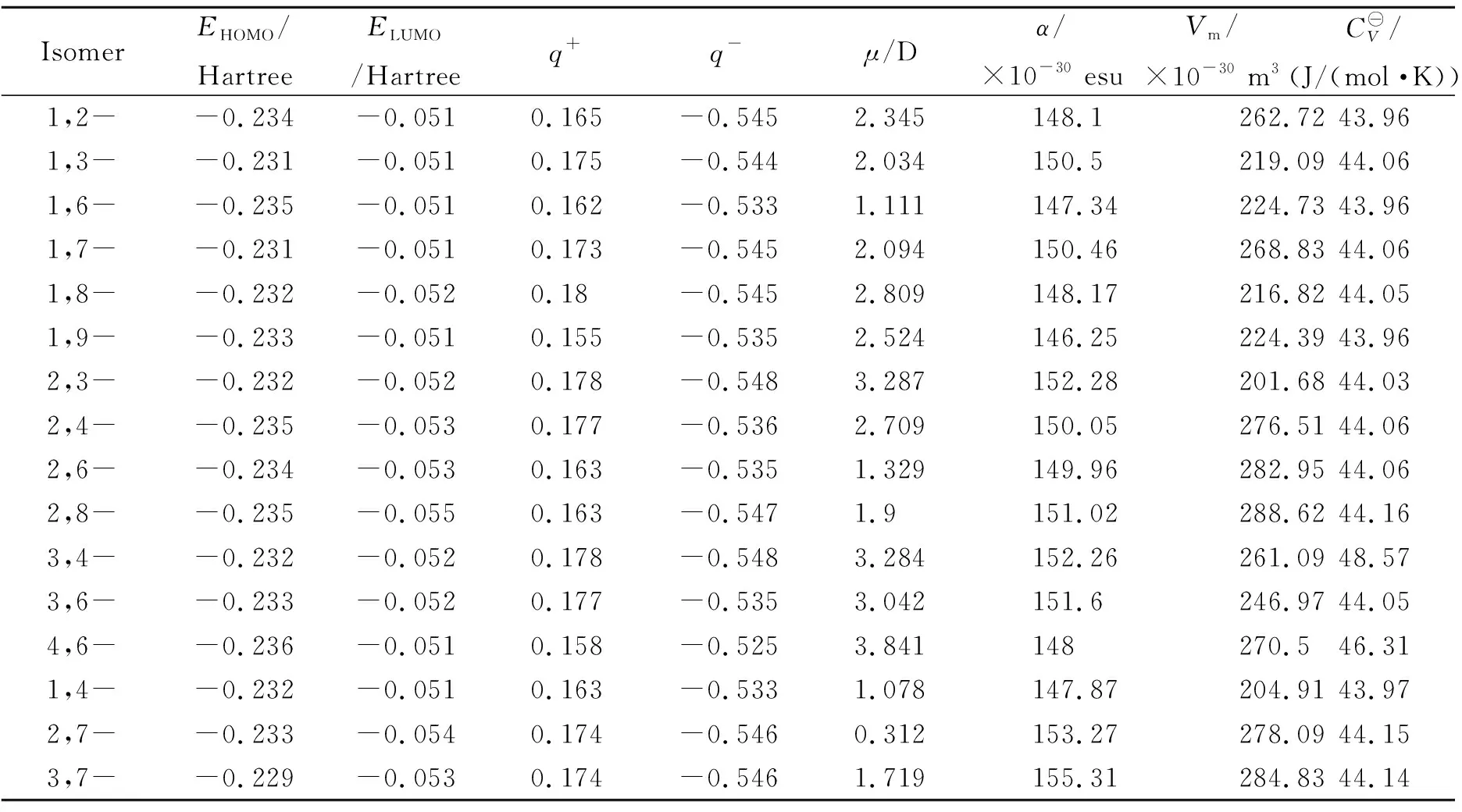应用人工神经网络预测多氯代二苯骈呋喃的色谱保留指数
2013-11-21曾玉香王炳强王志英
王 超,曾玉香,王炳强,孙 义,王志英
(1.天津市环境保护科学研究院,天津 300191; 2.天津渤海职业技术学院 环境工程系,天津 300402)
二噁英有强烈致癌、致畸、致突变的特性,而且极端难降解,能高度累积,造成对生态平衡和人类健康的潜在威胁[1]. 二噁英是一类卤代含氧三环芳烃类化合物,包括多氯代二苯骈二噁英(PCDD)、多氯代二苯骈呋喃(PCDF)、多氯联二苯(PCB)、以及溴代物和其他混合卤代物. 多氯代二苯骈呋喃(PCDF)共有135 种异构体. 在有关PCDF的环境监测和痕量分析方法中,气相色谱中的保留指数(IR)和相对保留时间(TRR)通常被用来检测环境中是否存在PCDF并区分不同的异构体[2-3]. 运用量子化学方法对分子进行结构优化和参数计算,建立分子结构参数与化合物的毒性[4-5]、溶解度[6]、分配系数[7]等性质的定量构效关系(QSPR/QSAR),已取得了满意的结果. 由于物质的结构参数与化合物性质不存在线性关系,运用多元线性回归等分析方法研究性质与结构参数之间的关系存在一定的局限性. BP神经网络通过处理若干简单非线性神经元的复合映射,可获得复杂的非线性处理能力,具有使非线性问题可调参数增加,拟合精度提高、结果更精确的特点,在各领域得到了广泛的应用. 本文作者探讨用量子化学密度泛函B3LYP/6-31G(d)方法计算PCDF系列化合物分子的结构参数,运用人工神经网络建立PCDF结构参数和色谱保留指数的定量构效关系,建立准确的色谱保留指数预测模型.
1 计算方法
1.1 结构参数计算方法
先用Hyperchem 4.5软件中的AM1半经验量子化学方法构建并优化各个PCDF化合物分子的初始几何结构,然后用Gaussian 03[8]程序在B3LYP/6-31G(d)水平上对各分子的结构进行优化,得到稳定构象,获得分子的量子化学参数.

1.2 神经网络构建方法

2 结果与讨论
2.1 结构参数


表1 部分样本的量子化学参数Table 1 Structure parameters of partial samples
2.2 人工神经网络预测结果



表2 训练样本色谱保留指数实验值和预测值Table 2 Experimental and predicted chromatographic retention indexes of training samples
将剩余的25组数据作为检验样本,经归一化后的8个参数作为输入,用上述训练好的神经网络模型预测PCDF的色谱保留指数,经反归一化处理得到检测样本保留指数的预测值,检测样本的预测值与实验值相对误差范围为-1.66%~2.39%,平均相对误差为0.31%,可见预测值与实验值基本相同(表3).

表3 检验样本色谱保留指数实验值和预测值Table 3 Experimental and predicted chromatographic retention indexes of examining samples

参考文献:
[1] HUFF J. 2,3,7,8-TCDD: A potent and complete carcinogen in experimental animals[J]. Chemosphere, 1992, 25: 173-176.
[2] DONNELLY J R, MUNSLOW W D, MITCHUM R K, et al. Correlation of structure with retention index for chlorinated dibenzo-p-dioxins[J]. J Chromatoagr A, 1987, 392: 51-63.
[3] RYAN J J, CONACHER H B S, PANOPIO L G, et al. Gas chromatographic separations of all 136 tetra-to octapolychlorinated dibenzo-p-dioxins and polychlorinated dibenzofurans on nine different stationary phases[J]. J Chromatoagr A, 1991, 541: 131-183.
[4] BRAIN W C, CLAUDIU T S. A physically interpretable quantum-theoretic QSAR for some carbonic anhydrase inhibitors with diverse aromatic rings obtained by a new QSAR procedure[J]. Bioorg Med Chem, 2005, 13(8): 2197-2211.
[5] SUNDARAM A, MASATOSHI M. Electron affinities and reductive dechlorination of toxic polychlorinated dibenzofurans: a density functional theory study[J]. J Phys Chem A, 2004, 108 (16): 3499-3508.
[6] BUSTAMANTE P, DRAGO R S. A new model for predicting solubilities and enthalpies of solution for a given solute in a series of solvents[J]. J Phys Chem B, 1997, 101(25): 5002-5009.
[7] VALKO K, SLEGAL P. Chromatographic separation and molecular modelling of triazines with respect to their inhibition of the growth of L1210/R71 cells[J]. J Chromatogr A, 1992, 592(1/2): 59-63.
[8] FRISCH M J, TRUCKS G W, SCHLEGEL H B, et al. Gaussian 03, Revision A. 1[CP]. Gaussian, Inc. Pittiburgh PA, 2003.
[9] NEEDHAM M D, JURS P C. Quantitative structure retention relationship studies of poly-chlorinated dihenzodioxins on gas chromatographic stationary phases of varying polarity[J]. Anal Chim Acta, 1992, 258: 183-198.
[10] HALE M D, HILEMAN F D, MAZER T. Mathematical modeling of temperature programmed capillary gas chromatographic retention indexes for polychlorinated dibenzofurans[J]. Anal Chem, 1985, 57: 640-648.
[11] 王海燕, 王晓栋, 赵劲松, 等. 应用分子全息对多氯代二苯骈呋喃的QSRR研究[J]. 科学通报, 2005, 50(5): 422-425.
